Created by Josh Bailey, Managed by Herohodgson– Last updated 3/18/21
Introduction
This is a companion piece to our Marvel Champions Expansion Guide and will focus on the ins and outs of each of the four aspects. In case you are new to this game, the purpose of this guide will be help you figure out which aspect is most fitting for the way you want to play the game. I will also go over how each aspect compares to the different classes of the Arkham Horror Card Game and the spheres of the Lord of the Rings Card Game, so that players coming from those games can get a head start on figuring out what will appeal to them. Finally, this article will cover some of sub-themes and deck archetypes of each aspect and include some good hero pairings for each. It’s important to note that the available card pool at the time of this writing is all player cards through to the release of Scarlet Witch.
Overall Thoughts on Each Aspect
Aggression
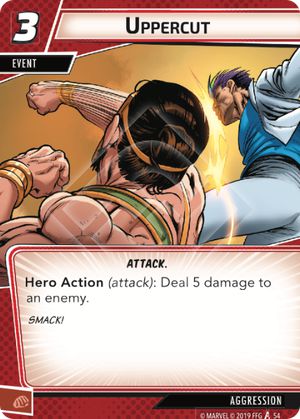
Aggression is the aspect for the players who want to be the primary damage dealer at the table. Damage dealt to the villain is, in all released scenarios so far, the victory condition for the heroes and Aggression is the aspect most-suited to achieving that goal. The primary weakness of most Aggression decks is a lack of thwarting. Unless you are on a well-balanced team, you will likely have to outrace the villain by dealing damage faster than threat can pile up on the main scheme.
It can be difficult to build a solo-Aggression deck that is viable, but it can certainly be done and generally requires a hero with at least a 2 in Thwart and some built-in thwarting in their signature cards. Key cards in Aggression solo are You’ll Pay For That, Brawn, and possibly Chase Them Down. In multiplayer, anything that deals damage is on the table as you’ll be leaned on to both damage the villain and possibly take care of minions for certain other deck types. A good mark to always aim for when playing Aggression is to deal at least 10 damage a round, whether in Solo mode or multiplayer.
If you’re coming from the Arkham Horror or Lord of the Rings LCG, comparing Aggression to the classes/spheres of those games depends a bit on your perspective. Because of the martial nature of this aspect, calling it Marvel’s version of the Guardian class or Tactics sphere is the most obvious comparison. But, that’s mostly due to theme. Mechanically, I would argue that Marvel’s Aggression is more akin to Arkham’s Seeker and LOTR’s Spirit, mostly because damage is the primary win condition in Marvel. In Arkham and LOTR, clue-gathering and questing are the primary win conditions, while attacking enemies is just necessitated by the encounter decks trying to slow you down, much like side schemes do in Marvel. The impact of combat and non-combat roles in Marvel is, in my opinion, inverted as compared to Arkham and LOTR. How you feel about this aspect compared to classes and spheres in the other two LCGs comes down to if your tastes are based in theme or mechanics. For some straight out the box fun, the stronger heroes for Aggression builds can be (but not limited to) Hulk, Thor, and Ant-Man. Most heroes however are compatible with this aspect though.
Justice
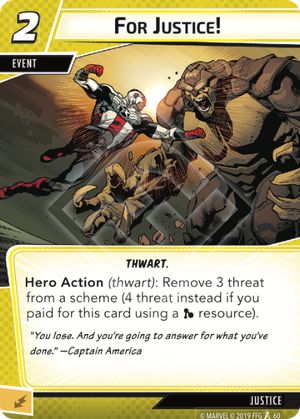
Justice is one of the two “Control” spheres meaning that it’s more about playing defensively and preventing the encounter deck from gaining a foothold against you while you and/or your teammates develop the board states you need to secure victory. You will be aiming to buy the heroes time and negate threats originating from the encounter deck. The weakness of the Justice aspect is dealing damage and just being proactive rather than reactive. You will be relying on your Justice cards to buy you the time you need for your Hero cards or teammates to actually win the game.
Justice is one of the most-oft used aspects for Solo because there are far more heroes who have enough built-in options for dealing damage but have fewer options for thwarting, and Justice fills that gap. Justice is also very useful in multiplayer because, with threat on most schemes scaling with player count, you will rarely run into the situation where you have cards to remove threat in your hand but not enough threat on the table to actually use them all. That situation can come up in solo. Solo Justice benefits greatly from Under Surveillance and Beat Cop, while multiplayer Justice is a good home for Jessica Jones, Followed, and Skilled Investigator.
As in my Aggression description above, comparing Justice to Arkham and LOTR is dependent on whether you’re looking at theme or mechanics. Thematically, this is the non-combat role that can feel like Arkham’s Seeker or LOTR’s Spirit. Mechanically, you are slowing down the encounter deck so that other players can do what they do to secure the win, and that feels more like Arkham’s Guardian and LOTR’s Tactics. There is also the sub-theme of Preparations in Justice that function a lot like Traps from LOTR’s Lore sphere. For this aspect, some of the stronger heroes can be (but not limited to) Quicksilver, Captain Marvel, and Spider-Woman. Most heroes however are compatible with this aspect as long as they have a base thrawt of 2 or more.
Leadership
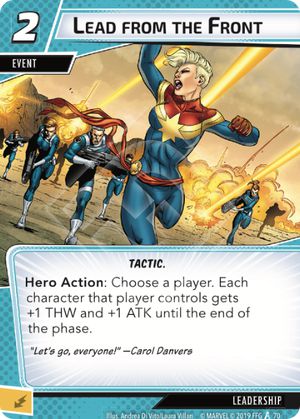
Leadership is a flexible aspect and right now, probably the strongest. It can do a little bit of everything, but it primarily leverages the Ally card type to great effect. Leadership is a flexible aspect that can do a little bit of everything, primarily leveraging the Ally card type to great effect. Because allies tend to have both Thwart and Attack stats, as well as the ability to defend, you can build your Leadership deck to remove threat, deal damage, block damage, or all of the above. Leadership’s primary weakness is that they are very dependent on those allies, so any scenario that has ways of removing allies from play more quickly or prevent them from entering play in the first place will effectively blank most of the cards in your deck. However, that’s not really seen much at this point in the game so Leadership is often one of the strongest aspects available to a given Hero. Another possible weakness, depending on personal taste, is that the dependence on allies can take the spotlight away from the Hero you’re playing and make a lot of Leadership decks feel same-y regardless of the chosen Hero.
Leadership is usually the strongest possible aspect for solo play due to flexibility and the extreme value you get from defending with allies. It doesn’t really lose much in multiplayer, either, because many cards that grant bonuses to characters can also be used to target your teammates and/or their allies. I don’t believe there are any Leadership cards that are better for solo than multiplayer, but you may find it difficult to play certain allies in multiplayer as the card pool grows and the potential for the uniqueness rule to come into play increases. Leadership as a whole is great in multiplayer, but special attention must be given to Maria Hill and Make The Call. Also, pulling off an epic Avengers Assemble in multiplayer is worth attempting for the fun of it if nothing else.
The experience of playing Leadership in Marvel is one of building up your board-state and then being able to steamroll over any particular challenge the encounter decks throws at you. I would say that is similar to playing a Mystic in Arkham as you depend on a single card type and are able to build towards any role that is needed. You could also argue that Marvel Leadership has some Guardian class tendencies with leveraging allies, but I think it’s kind of a different experience in that regard. For Lord of the Rings, the obvious comparison is the Leadership sphere, and that’s mostly true. Both feature cards that can grant bonuses to other players as well as get a swarm of allies on the table. And both Leaderships can also be used to handle combat or non-combat duties while being a little less focused than other aspects/spheres. Captain America with Leadership is arguably the strongest deck in the game, but other strong heroes for Leadership builds can be (but not limited to) Doctor Strange, Captain Marvel, and Black Panther. Any hero with a solid hand size will certainly be beneficial to give you the flexibility to play at least one ally and an event each round.
Protection
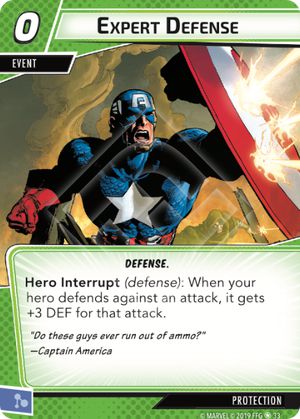
Protection is mostly about defending attacks and preventing/healing damage, though there is also a sub-theme of cancelling/manipulating boost cards and treachery cards. It is the other “Control” sphere of Marvel along with Justice. Protection mitigates attacks and damage while Justice mitigates scheming and threat. Protection’s biggest weakness is threat removal, so it has similar hero preferences to Aggression in that respect. Protection is often about making the villain phase of the turn a non-issue, and using reactions to deal damage back to enemies before or as they attack you.
Solo Protection can be very powerful with the right hero as all the damage prevention and healing means you can stay in Hero form almost indefinitely, which greatly reduces the pressure of removing threat. Compared to solo Justice, it is easier to negate almost all damage and be left with usually only one threat to deal with per turn than it is to negate almost all threat on the board, but still have to deal with full-strength villain and minion attacks. In multiplayer, being able to handle your own villain attacks as well as those of at least one other player, allows them lots of freedom to stay in Hero form and deal damage or thwart more than they otherwise would. The main difference between solo and multiplayer Protection deck lists is, likely to be how many card slots are devoted to readying for extra defenses like Indomitable and Desperate Defense. Unflappable is also a great card to get your hand size back up when defending and playing events in the villain phase.
Protection is the home of healing and encounter deck manipulation so far, so it fits pretty well alongside the Lore sphere in LOTR, and is appropriately green. The other primary reason LOTR players use Lore – card draw – is not emphasized the same way in Marvel so that cannot really be compared. Arkham Horror players that like the scrying and cancelling of the Mystic class may be drawn to Marvel’s Protection aspect, although Protection’s emphasis on mitigating enemies without necessarily attacking them outright may seem familiar to fans of Arkham’s Rogue class and its focus on evasion and damage through trickery. Protection can sometimes feel strange, as you may have rounds playing most of your cards in the villain phase. To really help a multiplayer team shine though, having a solid protection player can really make the difference to nullifying a villain. Look out for Spider-Man, Black Widow, and Ms. Marvel if you’re trying to enhance your protection ability. Quicksilver is also incredible in this mode with his free defend ability.
But What About the Survivor Class?
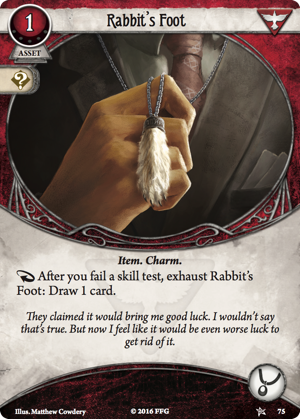
You may have noticed that I did not compare any of the Marvel aspects to Arkham’s Survivor class, and you probably are not surprised by that. Interestingly, the designers of Marvel Champions mentioned that there was a fifth aspect in the early stages of development and that it centered around self-sacrifice and triggering effects through intentionally causing yourself hardship. It was called Determination and it sounds extremely Survivor-y. However, with the four aspects released, if you are a Survivor fan from Arkham Horror then you will probably have to find your preferred playstyle by looking at each hero on a case-by-case basis. As of right now, the only Marvel hero that screams Survivor to me is Ms. Marvel and also possibly Thor. I mention Thor because he benefits from the otherwise negative effect of engaging an enemy, he has a card that can sometimes hurt you more than it helps, and he is also at his best when doing some combo-trickery involving sending his hammer to the discard pile and bringing it back. Calling all of that Survivor-esque is admittedly a bit of a stretch, though. Ms. Marvel is the most plausible one because her stats mean you almost cannot play her in the same conventional way as other heroes and her gimmick is unlike any other. Pulling off some quirky lines of play to make up for underwhelming stats seems like a Survivor strategy to me.
Current Archetypes to Consider
Below are some specific deck types you could build around beyond just the basic concepts presented above.
Aggression
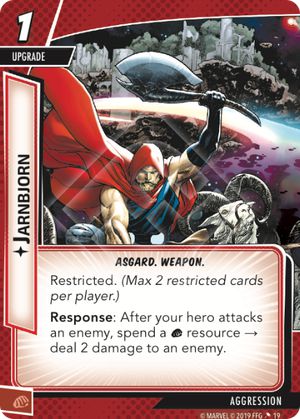
Weapons – The main Aggression cards to consider here are Jarnbjorn and Mean Swing. The only other weapons in the game currently are in certain heroes’ signature cards. Jarnbjorn wants physical resources so it pairs well with cards like Hulk ally, Martial Prowess, Skilled Strike, and Quincarrier. Some good hero options for this deck are Black Panther, Captain America, Black Widow, Thor, and Hawkeye. You only really need the Thor pack to try this one out, but the Hulk pack also helps for more physical resources. Wasp also helps bring some pretty unique events as well, such as Into The Fray – which is fantastic for doing a little thwarting as you hit hard.
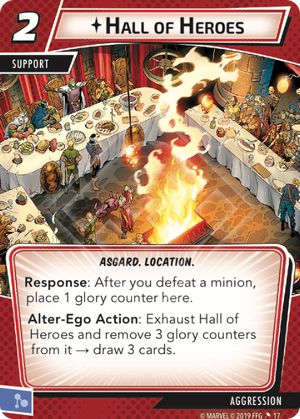
Minion Control – If you want to build your deck around handling minions for the entire table, look at Relentless Assault, Get Over Here, Chase Them Down, Battle Fury, Tigra, Valkyrie, and Hall of Heroes. The marquee hero for this build is Thor – and he is also the pack you want to buy for the aforementioned cards – but you can also get good mileage out of Black Widow, Captain America, She-Hulk, Hulk, Black Panther, and Spider-Man. Hawkeye is potentially an option with his Explosive Arrow, but it would be a little bit different of an approach because he generally doesn’t want to take minion attacks if he can help it. The Quicksilver pack brought us Beat ‘Em Up as well, which is phenomenal for going against minion heavy decks.
Justice

“Drip feed” vs “Burst” Thwarting – This is not so much a single archetype as it is a consideration of how you want to focus or balance these two types of thwart options. By “drip feed” I mean sources of small but repeatable thwarting like Surveillance Team, Beat Cop, and Interrogation Room. It’s enough to offset the regular accrual of threat during Step 1 of the Villain Phase, but not generally quick enough to respond to bad side schemes or quickly save you when completing the main scheme is imminent. For those situations you want “burst” thwarting that removes a large amount at one time, but maybe comes from an event that won’t always be available in your hand like For Justice!, Counterintelligence, Spider-Man ally, or Jessica Jones in certain situations. For solo, the drip feed type can be enough if your hero can soak attacks and stay in hero mode. For multiplayer, and any time your hero is nearly incapable of thwarting on their own, you will definitely want multiple sources of burst thwarting.
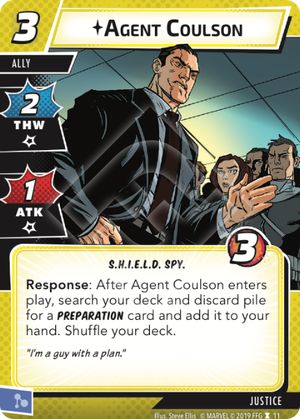
Preparations – This is currently the only true archetype distinct from generic Justice builds and is probably only viable in Black Widow and requires purchasing her pack. There are preparations for every aspect and also basic preparations, but the ability of Agent Coulson and the fact that Justice has one more Preparation than other aspects means Justice is the undisputed home for this deck right now. You might not even run Coulson, however, outside of a Black Widow deck. Outside of Black Widow’s signature cards, the centerpiece of the deck is Agent Coulson searching out either Counterintelligence or Spycraft as needed. You could maybe make a case for Black Panther for this archetype as Shuri can also get the preparations out of the deck. A lot of the great Justice cards are also of an energy resource type, making Captain Marvel really shine in this aspect with so many of her cards synergizing with this resource.
Leadership
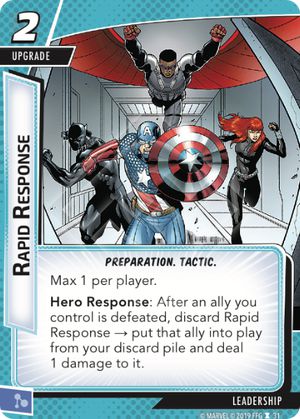
Ally Swarm – This type of deck is all about getting as many allies into play as often as possible. Rapid Response can be a key card in this deck, along with Make The Call. Rapid Response works well with big allies like Goliath and Nick Fury, or even just Maria Hill, in order to not only get an ally, back but draw a card too. Beyond providing sources of damage and thwarting, allies in this deck are important to use as defenders so that they can block a big attack and also remove themselves from play so you have an open slot for a new ally. This type of strategy can be powerful in any hero, but it’s possible that the repeated playing of allies can get expensive so it can be easier to pull off with a hero that has additional resource cards in their signature set like Captain Marvel or Black Panther. If you’re wanting to try this archetype, you will need the Ant-Man pack, which contains most of the leadership upgrades you need.

Voltron Allies – This still-developing archetype is differentiated from the above type of ally build in that you are investing in upgrades for your allies and keeping them around for multiple turns or potentially the whole game. Some key cards here are Iron Man ally, Inspired, Team Training, and the upcoming Reinforced Suit. You are less likely to depend on your allies for defense with a build like this, so you probably will not want to use a hero that cannot defend or take much damage. Otherwise, the same hero considerations from above will apply because while you are playing allies less often, you’re making up for that by investing in upgrades and potentially healing. Another interesting hero to consider here is Spider Woman, because she can combine aspects to get otherwise-impossible combinations of upgrades and allies on the board.
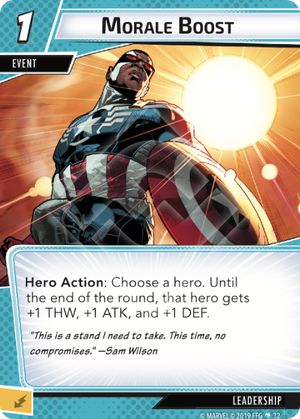
Hero Buffing – It seems as though Leadership will have a secondary focus on giving out stat boosts and other helpful effects to heroes, so this could be a way to build a multiplayer Leadership deck that isn’t so ally-focused. Cards like Lead From The Front, Avengers Assemble, and Morale Boost are really the only options available now from the Leadership aspect. They can be combined with other Basic options like Endurance, Down Time, and Honorary Avenger to give your teammates better survivability. The only hero that may be specifically-suited to this role is Doctor Strange, as he has built-in options for boosting other heroes’ stats, handing out tough statuses, and managing other status effects that teammates may have picked up.
Protection
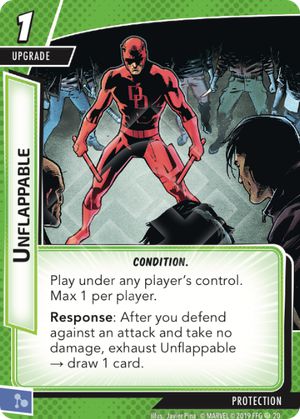
Defend And Take No Damage – There is probably a more clever name for this one, but the idea is that you can defend, for yourself and possibly others as well, without taking damage and then gain benefits for doing so. The obvious card that makes this deck worthwhile is Unflappable, but you can also look at Desperate Defense and, if you’re going to be defending anyway, Electrostatic Armor and Preemptive Strike and possibly Indomitable. Since you are set up to defend without much worry and possibly even profit from it, it is worth considering Get Behind Me! depending on the villain. The three best hero options here are probably Spider-Man for his card draw, Black Panther for retaliate, and Captain America for retaliate and the ability to ready despite defending.
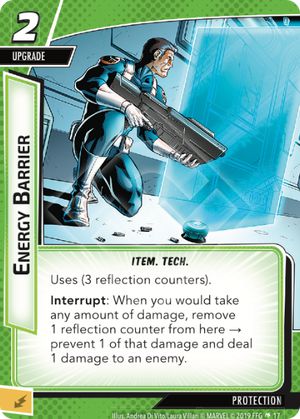
Never Defend – The opposite Protection strategy is, counter-intuitively, to never actually defend. This can be accomplished by canceling or preventing damage with Energy Barrier, Defensive Stance, and Nova ally who can potentially defeat an attacking minion before they deal damage. You may also want to include some options for healing since you will most likely still take some amount of damage, so Momentum Shift and possibly Second Wind are worth considering. You can also get by with ally blocking like a Leadership player with Clea who is a cheap ally that will appear twice as often. Multiple Man, found in the Quicksilver pack, may seem pricey at 4 cos,t but brings 3 allies into play at once to defend. This is the style of Protection that can work with Iron Man (using Electrostatic Armor and Energy Barrier to increase his hand size) and any hero that starts with a low Defense stat that is not worth increasing such as Captain Marvel or has a high enough hit point total to not worry about it like Thor or Hulk.
If you enjoy this resource and would like to support this writer, please check out our “Support a Writer” tier over on our Patreon page and select HeroHodgson.
Also please consider joining our Discord channel, to discuss this resource and more.

I really wish I had found this article sooner! II started Marvel primarily as a quick way to scratch the LCG itch usually solved by LOTR or Arkham. This is smartly written and incredibly instructive. Thanks!
LikeLike